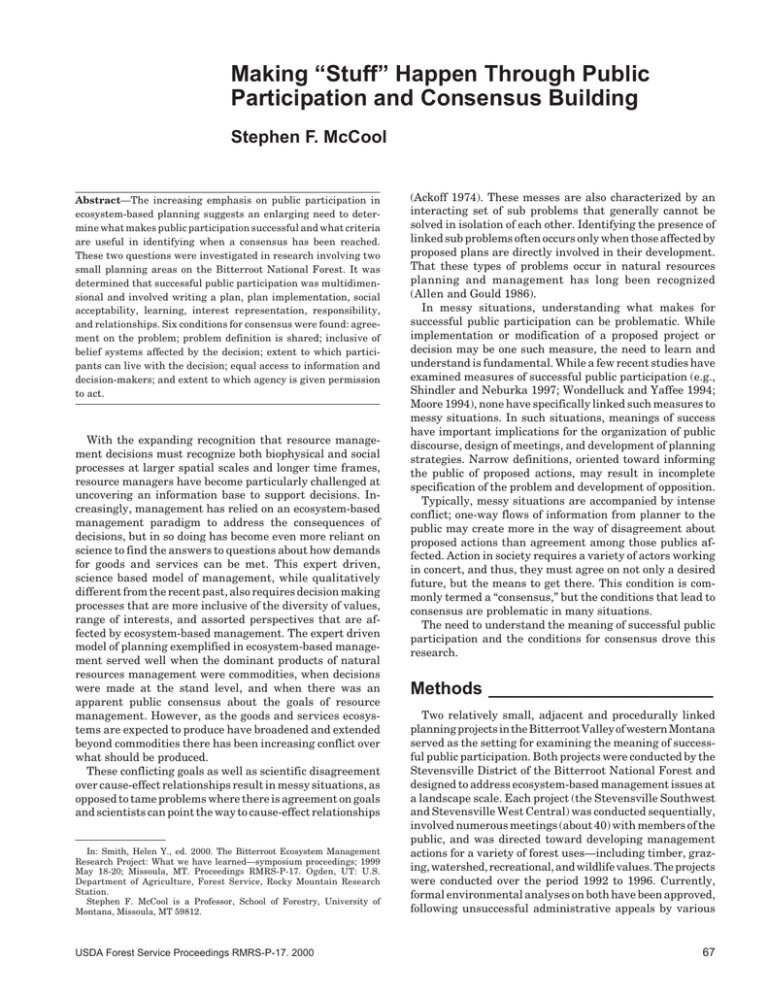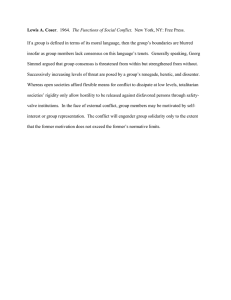Making “Stuff” Happen Through Public Participation and Consensus Building Stephen F. McCool
advertisement

Making “Stuff” Happen Through Public Participation and Consensus Building Stephen F. McCool Abstract—The increasing emphasis on public participation in ecosystem-based planning suggests an enlarging need to determine what makes public participation successful and what criteria are useful in identifying when a consensus has been reached. These two questions were investigated in research involving two small planning areas on the Bitterroot National Forest. It was determined that successful public participation was multidimensional and involved writing a plan, plan implementation, social acceptability, learning, interest representation, responsibility, and relationships. Six conditions for consensus were found: agreement on the problem; problem definition is shared; inclusive of belief systems affected by the decision; extent to which participants can live with the decision; equal access to information and decision-makers; and extent to which agency is given permission to act. With the expanding recognition that resource management decisions must recognize both biophysical and social processes at larger spatial scales and longer time frames, resource managers have become particularly challenged at uncovering an information base to support decisions. Increasingly, management has relied on an ecosystem-based management paradigm to address the consequences of decisions, but in so doing has become even more reliant on science to find the answers to questions about how demands for goods and services can be met. This expert driven, science based model of management, while qualitatively different from the recent past, also requires decision making processes that are more inclusive of the diversity of values, range of interests, and assorted perspectives that are affected by ecosystem-based management. The expert driven model of planning exemplified in ecosystem-based management served well when the dominant products of natural resources management were commodities, when decisions were made at the stand level, and when there was an apparent public consensus about the goals of resource management. However, as the goods and services ecosystems are expected to produce have broadened and extended beyond commodities there has been increasing conflict over what should be produced. These conflicting goals as well as scientific disagreement over cause-effect relationships result in messy situations, as opposed to tame problems where there is agreement on goals and scientists can point the way to cause-effect relationships In: Smith, Helen Y., ed. 2000. The Bitterroot Ecosystem Management Research Project: What we have learned—symposium proceedings; 1999 May 18-20; Missoula, MT. Proceedings RMRS-P-17. Ogden, UT: U.S. Department of Agriculture, Forest Service, Rocky Mountain Research Station. Stephen F. McCool is a Professor, School of Forestry, University of Montana, Missoula, MT 59812. USDA Forest Service Proceedings RMRS-P-17. 2000 (Ackoff 1974). These messes are also characterized by an interacting set of sub problems that generally cannot be solved in isolation of each other. Identifying the presence of linked sub problems often occurs only when those affected by proposed plans are directly involved in their development. That these types of problems occur in natural resources planning and management has long been recognized (Allen and Gould 1986). In messy situations, understanding what makes for successful public participation can be problematic. While implementation or modification of a proposed project or decision may be one such measure, the need to learn and understand is fundamental. While a few recent studies have examined measures of successful public participation (e.g., Shindler and Neburka 1997; Wondelluck and Yaffee 1994; Moore 1994), none have specifically linked such measures to messy situations. In such situations, meanings of success have important implications for the organization of public discourse, design of meetings, and development of planning strategies. Narrow definitions, oriented toward informing the public of proposed actions, may result in incomplete specification of the problem and development of opposition. Typically, messy situations are accompanied by intense conflict; one-way flows of information from planner to the public may create more in the way of disagreement about proposed actions than agreement among those publics affected. Action in society requires a variety of actors working in concert, and thus, they must agree on not only a desired future, but the means to get there. This condition is commonly termed a “consensus,” but the conditions that lead to consensus are problematic in many situations. The need to understand the meaning of successful public participation and the conditions for consensus drove this research. Methods _______________________ Two relatively small, adjacent and procedurally linked planning projects in the Bitterroot Valley of western Montana served as the setting for examining the meaning of successful public participation. Both projects were conducted by the Stevensville District of the Bitterroot National Forest and designed to address ecosystem-based management issues at a landscape scale. Each project (the Stevensville Southwest and Stevensville West Central) was conducted sequentially, involved numerous meetings (about 40) with members of the public, and was directed toward developing management actions for a variety of forest uses—including timber, grazing, watershed, recreational, and wildlife values. The projects were conducted over the period 1992 to 1996. Currently, formal environmental analyses on both have been approved, following unsuccessful administrative appeals by various 67 interests. The public participation process involved a variety of formats, including typical agency informational meetings, small group processes, field trips, and presentations from participating scientists. Both projects were similar in size (about 40,000 acres) and scope of issues. Each was based on the concept of ecosystembased management. The Stevensville West Central Unit had a significantly higher level of public involvement in an attempt to create a consensus about management direction. In addition, a focused scientific effort was initiated by the (then) Forest Service Intermountain Research Station to create a larger information base upon which to make decisions. Scientists from various programs and departments from The University of Montana also participated. An important feature of the scientific participation involved presentations by scientists to both federal managers and members of the public to increase awareness of important ecosystem processes and functions in the planning area. In this study, all scientific and managerial participants in the project were interviewed to identify meanings of success. About half the public participants were sampled. Public participants (which included a typically wide range of beliefs and political positions about natural resources management) interviewed were sampled to achieve representativeness of perspectives on the project. In addition, some participants were unavailable for an interview; only one declined. Interviews were conducted in the summer and fall of 1996, with six additional follow-up interviews initiated in the summer of 1997. Forty individuals were interviewed. All interviews were conducted on a confidential basis. Interviewees were asked about a number of process characteristics, including their perceptions of the public participation component of the planning effort. Each participant was asked if the participation component was successful, and then followed up with questions about why (either it was or was not successful). Following this discussion, each was also asked whether a consensus existed and what conditions were needed to reach it. Each interview was tape recorded with the permission of the individual and was later transcribed. Transcribed interviews were subject to a content analysis; key concepts were identified and marked using Ethnograph statistical software. Both Guthrie (1997) and McCool and Guthrie (1998) provide additional detail on methods and results. Results ________________________ Interviewees identified a number of dimensions of successful public participation. Obviously, the ability to change the future to a more desirable one through writing and implementing a plan is an important dimension. As one respondent stated, “stuff’s gotta happen.” However, this narrow definition of success was not widely shared by respondents in this study. Study informants identified other dimensions critical to a successful process. These dimensions include identifying the social acceptability of plan alternatives. Since public resources must be organized to implement any plan in the public domain, social acceptability is critical as noted by several interviewees. These product-oriented measures of success are particularly important in tame problem situations, but for messy 68 problems—where there is disagreement and uncertainty— are rather limited. Given the need for greater amounts of inclusiveness and legitimate consideration of a wider range of values, these other dimensions appear essential for successful public participation in messy situations. First, respondents emphasized learning-oriented dimensions of success. In this sense, learning was most often discussed as a two-way or interactive concept. In this respect, learning is differentiated from education—which a number of scientists in our study identified as an important dimension. The learning that occurred appeared to concern not only the topic—ecosystem-based management (as applied to the specific areas involved here)—but also the process of communicating with each other, and understanding legal and policy processes that guide planning and management. Interviewees in this study also identified responsibility (in the sense of ownership) as another dimension of success in two ways: first, seeing their input reflected in the document or decision, and second, feeling like their issues and concerns were accepted and considered. Responsibility for an area/plan differs from acceptability in the sense that a plan produced by an agency distant from the public may be satisfactory (and acceptable), but the public may have no feeling that they helped write the plan. Responsibility may be important in securing the resources necessary for implementation. This dimension was particularly important for the public. Still another dimension of successful participation identified by the informants in this study deals with relationships not only between managers and members of public but also among the public and between scientists and the public. Relationship building goes to the heart of the trust issue, which has plagued many federal agencies over the last decade or so. In many respects, planning represents a redistribution of power, away from entrenched interests to those who have formerly been relatively powerless; in this sense, a broad representation of various interests in the planning process is essential, as recognized by many interviewees in this study. In part, interest representation includes not only a variety of stakeholders but also access to the planning process. Interviewees identified six conditions necessary for achieving consensus on a proposed course of action. An underlying element of the consensus concept is the notion of agreement not only on a resolution to the problem, but also on the definition of the problem itself. Thus, the extent to which there is a shared definition of the problem is an important condition necessary to achieving consensus. As Bardwell (1991) notes, too much problem solving activity is directed toward solving the wrong problem or solving a solution. Shared definitions help in directing the course of discussion. In order to create consensus, there must be agreement that the problem can be resolved through public participation processes, the second condition identified by respondents. This condition is critical because some, particularly scientists and managers, may hold beliefs that only expert or scientific knowledge is necessary for the planning process. Ecosystem-based management has largely been defined as a scientific process, with the public more or less on the USDA Forest Service Proceedings RMRS-P-17. 2000 outside looking in and playing a role only marginally different from the formal public participation requirements of National Environmental Policy Act (NEPA). Informants in this study, however, felt that public participation was an essential, if not sole, component of the planning process. Public participation processes that attempt to build consensus must be inclusive of the belief systems that are affected by policy, the third condition. There was recognition among nearly all interviewees that a consensus building process must be inclusive of various values and interests, and at least some participants recognized a good faith effort on the part of the agency to be inclusive. This is an important finding because perceptions of process go to the heart of concerns about trust and legitimacy. A process that is viewed as exclusive or biased at the beginning will have little social validity at its closing, if it makes it that far. The extent to which the process is viewed as inclusive is positive and conducive to building consensus and trust with the agency. The fourth condition deals with the heart of consensus, the extent to which participants can live with results. The nature of agreements made in a public participation process is the basis of consensus, and, as noted earlier, there is a lack of attention to this fundamental question in the literature. To some, consensus may mean unanimous opinion, to others a general agreement, and to still other participants, a level of agreement where some participants may be happy and others may go along grudgingly. The variety of definitions of agreement or consensus can be a significant stumbling block to knowing when “agreement” has been reached and when to move on to other issues. However, in this case, most respondents independently identified a “can live with it” definition. People must engage each other on equal footing in order for authentic interaction to occur. In the Stevensville projects, Forest Service planners and scientists attempted to communicate the technical data and modeling needed to better understand the ecosystem. This was done through numerous public meetings and field trips. The effect of this attempt may not have been to resolve a particular planning problem as much as to increase awareness of ecological processes. Communicating scientific knowledge to the public and agency planners was a fundamental objective of the planning effort. The comments reported here suggest that achieving this goal was inhibited by value differences, particularly between the agency and its publics. Which facts people agree to and which they do not hinders problem definition; the data presented here suggest some confusion about the problem definition. A variety of other factors, including fundamental belief systems about the management of public lands and trust levels, intervene in developing a consensus. The data also suggest that scientists need to consider the varying cognitive capacities of public members when communicating the complex ecological principles of ecosystembased management. The sixth condition identified was the extent to which an agency was given “permission” to act. The idea of informed consent has been in the literature for many years. If the agency does not have the confidence of its public to implement actions, it has lost its legitimacy as agent of public policy. Permission to act occurs at a general level and does USDA Forest Service Proceedings RMRS-P-17. 2000 not mean unanimous acceptance. In the complex and contentious situations confronting natural resources, such agreement would be rare and unrealistic to expect. One manager observed that not all people will agree with proposed actions and that it is important for planners to recognize this. While one manager was rather fatalistic about the project-achieving consensus (“We will NEVER make everyone happy nor is this possible”), a scientist felt “that it’s better than no process whatsoever” even though this scientist felt that a consensus had not been achieved. Conclusions ____________________ This research certainly suggests that involving the public in natural resource planning, while ultimately worthwhile, is anything but easy. The research points to the need to build such processes on clearly established goals (e.g., learning) and to have clarity into the meanings of important terminology. In the case studies used in the research reported here, the public participation process was extensive, and while not every participant could live with all the results, it did seem to result in a set of outcomes more representative and acceptable than a traditional NEPA process would have led to. The process of building consensus is confronted by considerable obstacles, including the lack of skill in leading public participation programs (suggestions for overcoming these are made by Shindler and Neburka 1997), and a number of institutional barriers. Major institutional barriers are the perceptions about the requirements of the Federal Advisory Committee Act (FACA), passed in 1972. This legislation prohibits advisory committees to the federal government that contain nonfederal employees without a specific charter from the General Services Administration. Because of several recent court cases involving FACA and natural resource planning, federal land management agencies have been reluctant to engage in intensive, consensus building public participation programs. The court interpretations of FACA have varied considerably, leaving many planners in a dilemma—wanting to engage the public in more deliberative processes, but also wanting to avoid legal entanglements that may lead to invalidation of any resulting plan or decision. The methodology used in this study was distinctly qualitative in nature. The objective was to map out the various dimensions of success and consensus, as viewed by participants. Future research would involve gaining a better understanding of the quantitative importance and external validity of these dimensions in other natural resource planning situations. Other research questions might investigate the strategies various groups employ when they perceive their positions are minority or majority ones, when belief systems of participants simply do not allow some alternatives to be considered, or when identifying effective ways for participants coming to similar definitions of the problem. References _____________________ Ackoff, R.L. 1974. Redesigning the future: A systems approach to societal problems. New York, NY: John Wiley and Sons. 260 p. 69 Allen, G.M.; Gould, E.M., Jr. 1986. Complexity, wickedness and public forests. Journal of Forestry. 84(4): 20-24. Bardwell, L. 1991. Problem framing: A perspective on environmental problem-solving. Environmental Management. 15(5): 603-612. Guthrie, K. 1997. Measures of success in public involvement processes: An investigation of how managers, researchers and members of the public define success. Missoula, MT: School of Forestry, The University of Montana. 98 p. Thesis. McCool, Stephen F.; Guthrie, Kathleen; Smith, Jane Kapler. 2000. Building consensus: legitimate hope or seductive paradox? Res. Pap. RMRS-RP-25. Fort Collins, CO: U.S. Department of Agriculture, Forest Service, Rocky Mountain Research Station. 14 p. 70 Moore, S.A. 1994. Interaction processes and the resolution of environmental disputes: Case studies from public land planning in the United States and Australia, College of Forestry, University of Washington, Seattle, WA. Shindler, B.; Neburka, J. 1997. Public participation in forest planning—8 attributes of success. Journal of Forestry. 95(1): 17-19. Wondolleck, J.M.; Yaffee, S.L. 1994. Building bridges across agency boundaries: In search of excellence in the United States Forest Service. (Ann Arbor, MI: School of Natural Resource and Environment, The University of Michigan). A research report to the U.S. Department of Agriculture, Forest Service, Pacific Northwest Research Station. USDA Forest Service Proceedings RMRS-P-17. 2000



